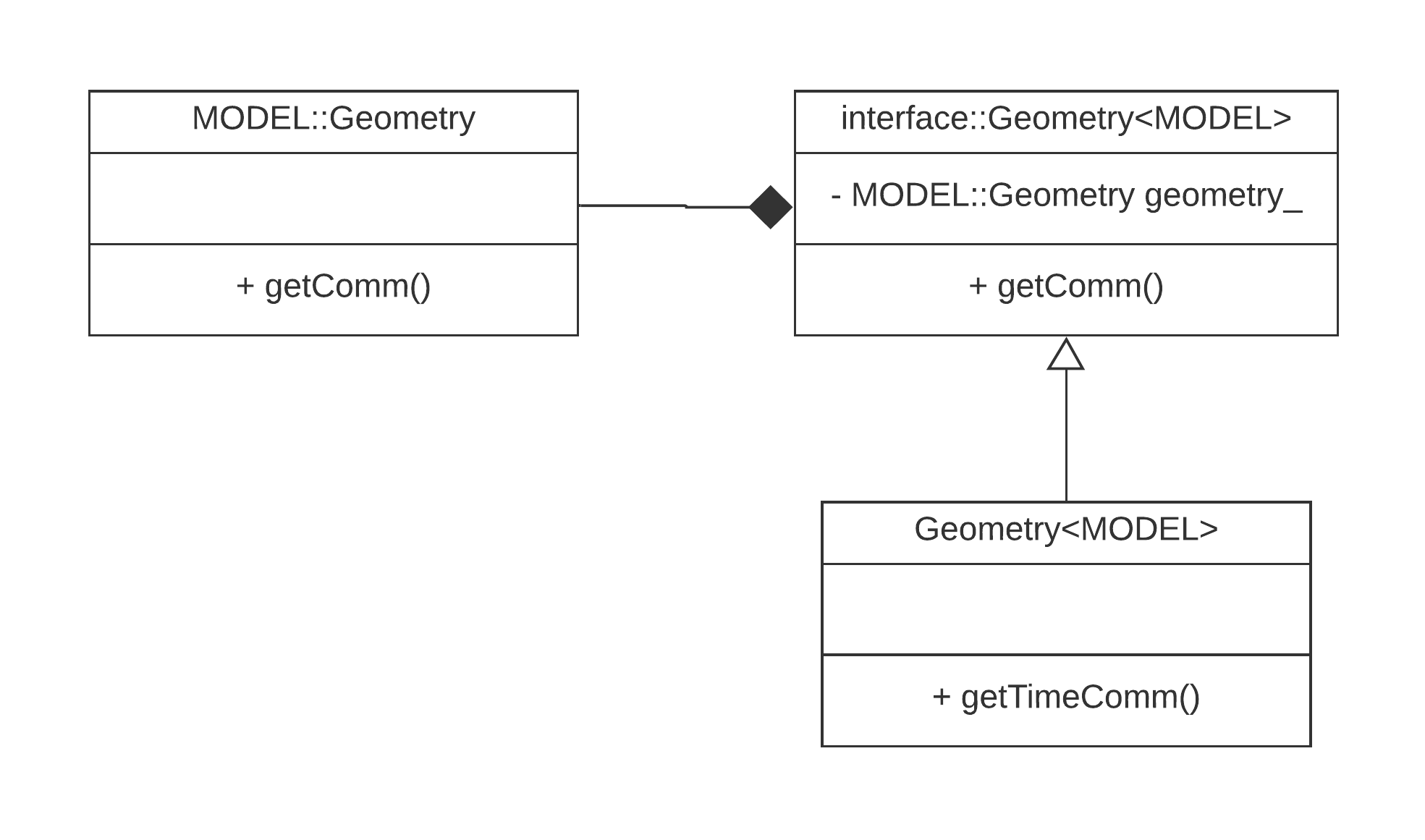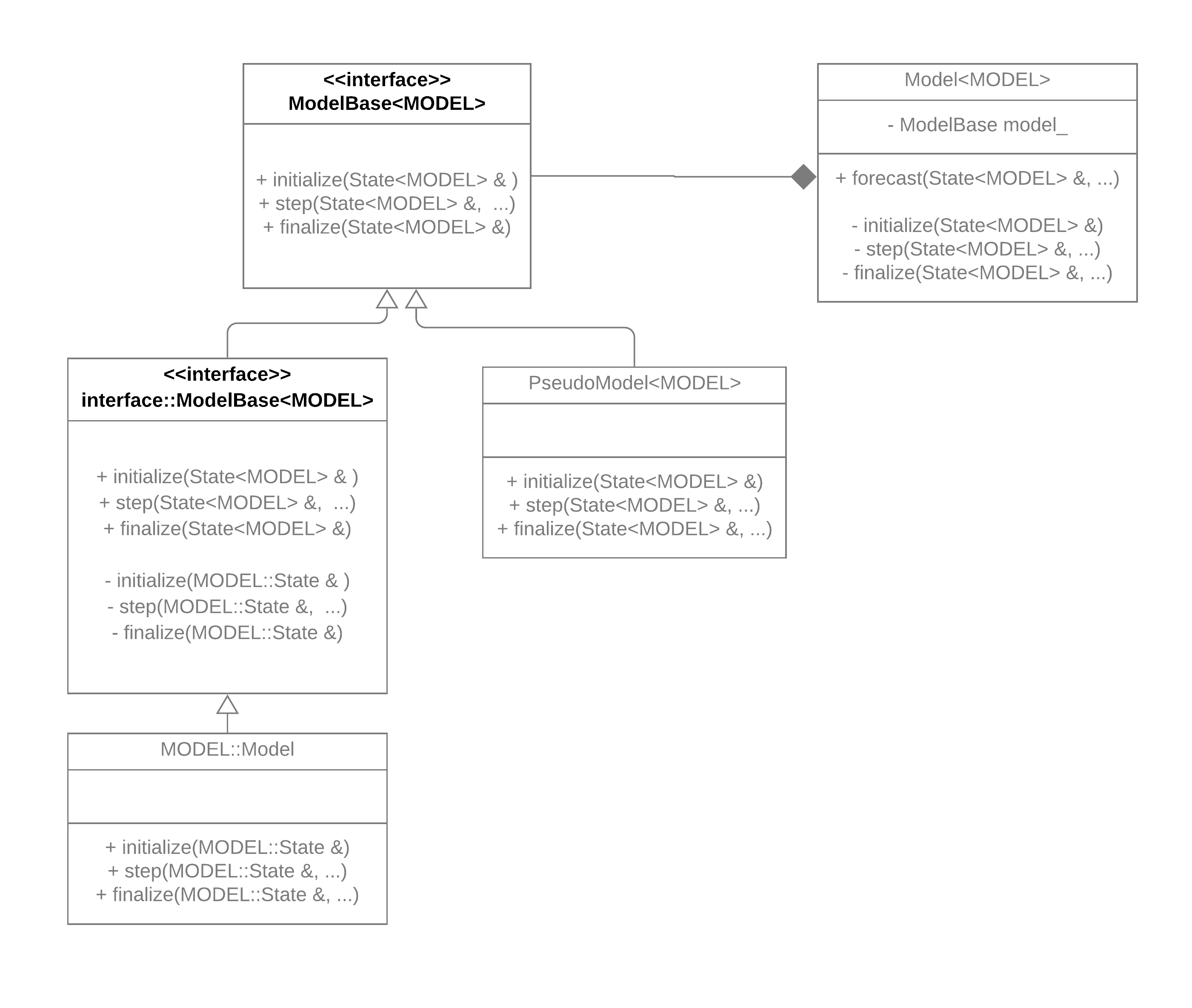OOPS interfaces¶
All OOPS applications interact with specific model- or observation- related implementations through interface classes. There are two kinds of interface classes, described below.
Interface classes chosen at build time¶
OOPS applications and classes are templated on OBS and/or MODEL traits. These traits are C++ structures defining which of the interface class implementations should be used in the current class or application.
OBS traits contain interface classes that are related to the observation processing:
ObsSpace: observation data handling for one obs type;ObsVector: observation vector (e.g. vector of observation values, or of computed H(x));ObsDataVector: templated on data type vector in observation space (oops currently usesObsDataVector<int>andObsDataVector<float>);ObsOperator: observation operator, used for computing H(x);LinearObsOperator: tangent-linear and adjoint of the observation operator;ObsAuxControl: auxiliary state related to observations (currently only used for bias correction coefficients, but can be used for other cases);ObsAuxIncrement: auxiliary increment related to observations (currently only used for bias correction coefficient increments);ObsAuxCovariance: auxiliary error covariance related to observations (currently only used for bias correction coefficient error covariances);ObsAuxPreconditioner: preconditioner for auxiliary error covariance related to observations (currently only used for the preconditioning of the bias correction coefficient error covariances);Locations: observations locations, used in the interface between model and observations, for interpolating model fields to observations locations to be used in H(x);GeoVaLs: geophysical values at locations: model fields interpolated to the observation locations; used in H(x);ObsDiagnostics: observation operator diagnostics: additional output from the observation operator that can be used in quality control.
There are currently three implementations of OBS traits in JEDI: lorenz95::L95ObsTraits used with the toy Lorenz95 model, qg::QgObsTraits used with the toy quasi-geostrophic model, and ufo::ObsTraits used with all realistic models connected to JEDI. ufo::ObsTraits lists classes implemented in ioda and ufo as the implementations of above interfaces. All the new models added to JEDI can make use of ufo::ObsTraits and do not have to implement any of the above classes.
MODEL traits contain interface classes that are related to models:
Geometry: model grid description, MPI distribution;State: analysis state, model state, ensemble member, etc;Increment: perturbation to a state;LocalInterpolator: optional, interpolator from/to state locations to/from specified locations on the same MPI task. IfLocalInterpolatoris not specified in theMODELtrait, a genericoops::UnstructuredInterpolator<MODEL>will be used as a local interpolator;VariableChange: variable change in the model space;LinearVariableChange: tangent-linear and adjoint of the variable change;ModelAuxControl: auxiliary state related to model (currently not used, could be e.g. model bias);ModelAuxIncrement: auxiliary increment related to model;ModelAuxCovariance: auxiliary error covariance related to model;ErrorCovariance: background error covariance (optional);GeometryIterator: iterator over model grid points (only used in theLocalEnsembleDAapplications);NormGradient: scale an increment (gradient) according to a given norm (only used inAdjointForecast).
Classes in the MODEL traits are typically implemented for each distinct model used in JEDI. Depending on the oops application, only a subset of these classes may have to be implemented.
Example of OOPS implementation of classes defined in traits¶
Fig. 1 shows class diagram for the Geometry class.

Fig. 1 Class diagram for Geometry-related classes¶
Here MODEL::Geometry implementation (an implementation of Geometry specified in the MODEL traits, e.g. Geometry implemented in Lorenz95 model, or fv3-jedi model, or mpas-jedi model) has to implement the interface defined in interface::Geometry<MODEL> class (in the interface directory in oops). interface::Geometry<MODEL> holds a pointer to MODEL::Geometry implementation; each of the methods in interface::Geometry<MODEL> calls a corresponding method in MODEL::Geometry (with added tracing and timing). If any of the interface::Geometry<MODEL> methods took SomeClass<MODEL> on input, MODEL::SomeClass would be passed during the call to the MODEL::Geometry implementation of the method.
Geometry<MODEL> (in the base directory in oops) is a class that is used in oops classes interacting with geometries. It is a subclass of interface::Geometry<MODEL> that has additional functionality that is implemented at oops level (and doesn’t have to be implemented in MODEL implementations).
Note
Not all the interface classes are implemented with interface::Class and Class distinction yet.
Note
For the interface classes that do not need additional functionality implemented at oops level (e.g ObsOperator, VariableChange), there is no need for interface::Class and Class distinction. In this case Class interface class is located in interface directory.
Interface classes chosen at runtime¶
For classes in this category, there could be multiple implementations of the class, both generic and specific. Generic implementations are templated on the MODEL and/or OBS trait and can be instantiated for any (or at least multiple) implementations of these traits. MODEL- and OBS-specific implementations are not templated on MODEL or OBS – they are tied to a specific implementation of these traits. The classes in this category are typically not defined in OBS or MODEL traits, and the class used in each particular case is decided at runtime, based on provided configuration file.
Some of the classes that are currently in this category: Model, ObsError, ObsFilter.
Fig. 2 shows class diagram for the Model class.

Fig. 2 Class diagram for Model-related classes¶
ModelBase<MODEL> class methods have templated parameters (e.g. State<MODEL> in the example). Its subclasses, generic implementations of Model, can operate on multiple implementations of MODEL traits (e.g. PseudoModel<MODEL> which “propagates” model by reading precomputed states from files). Both ModelBase<MODEL> and generic implementations of Model reside in generic directory in oops.
interface::ModelBase<MODEL> (in the interface directory) is a subclass of ModelBase<MODEL> that overrides all methods that take templated parameters with calls to the abstract methods that take parameters tied to a specific implementation of the traits (e.g. MODEL::State in the example). Subclasses of interface::ModelBase<MODEL> are not templated on MODEL and are tied to specific implementations of MODEL trait (e.g. Lorenz95 prognostic model, FV3-GEOS, FV3-GFS, etc).
Model<MODEL> (in the base directory) holds a pointer to ModelBase<MODEL>. It has methods that correspond to all the methods in ModelBase<MODEL>; each of those methods calls a corresponding method in ModelBase<MODEL> (with added tracing and timing). There is also additional functionality in Model<MODEL> that is included at oops level (and doesn’t have to be included in the implementations), e.g. forecast method.
Note
Not all the interface classes in this category are implemented according to the above class diagram yet, but the intention is to implement all of them in a similar way.